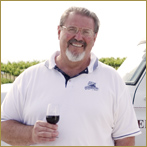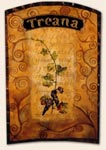 PASO ROBLES, Ca. – When Gary Eberle turned out his first wines at the Estrella River Winery in the early 1970s, he had big dreams for the Paso Robles wine region.
PASO ROBLES, Ca. – When Gary Eberle turned out his first wines at the Estrella River Winery in the early 1970s, he had big dreams for the Paso Robles wine region.
Situated halfway between Los Angeles and San Francisco in the heart of California’s vast Central Coast, El Paso de Robles had everything an aspiring winemaker could want: enough daytime heat to ripen hearty grape varieties such as Cabernet Sauvignon, and cool evening temperatures to keep the acids lively and fresh.
Only 20 miles inland from the Pacific, Paso is said to have California’s greatest temperature swing from day to night. Eberle planted Syrah, Cabernet, Merlot, Chardonnay, Muscat and a host of other grapevines as Estrella quickly grew to a half-million cases of production annually.
Those early vintages only cemented Eberle’s belief in the potential for fine wine in the region. He helped establish the Paso Robles appellation in 1980 and eventually left Estrella (now the site of Meridian Vineyards) to open his own winery in 1983. But despite his early successes, Eberle still felt like the Lone Ranger. After 10 years there were fewer than 25 wineries in the area.
Today there are well over 200 and counting, a swelling of the winery ranks Eberle believes is long overdue.
‘I always thought this area would take off,’ he said recently. ‘I just never dreamed it would take this long.’
 The conversation took place over barbecue at the spectacular new Vina Robles Winery vistor’s center, located on Highway 46 east of the Paso Robles town center, and just down the road from Eberle’s own place.
The conversation took place over barbecue at the spectacular new Vina Robles Winery vistor’s center, located on Highway 46 east of the Paso Robles town center, and just down the road from Eberle’s own place.
It is one of the newcomers that helped propel the image of Paso Robles as a desirable wine appellation. Some that quickly come to mind are Tablas Creek, Treana and Robert Hall, but there are scores of others.
Much of the recent development was driven by a severe grape shortage in the 1990s coupled with relatively inexpensive vineyard land (compared to Napa and Sonoma), and some of it had to do with the widely held notion that Paso Robles seemed to be one of California’s most hospitable environments for the so-called Rhone grape varieties – Syrah, Mourvedre, Grenache, Viognier, Marsanne and Roussanne.
Though Eberle was the first vintner to plant Syrah in the region (and frequently dubbed the ‘father’ of Paso Robles wine) Eberle isn’t convinced the future belongs entirely to the Rhone grape varieties.
‘Everyone says Rhone, Rhone, Rhone . . . Syrah, Syrah, Syrah,’ said Eberle. ‘But I still say Cabernet Sauvignon is our best wine. I love to go against Napa Valley Cabernets with my own. A Paso Robles Cabernet is softer and more drinkable when it’s young, and anyone who says they won’t age simply doesn’t know. I still have a few of my Cabernets from the 1970s that are holding up just fine.
‘And a Paso Robles Cabernet is a fraction of the price!’
Eberle recently sat on a seminar panel that looked at Paso Robles Rhone blends versus traditional blends from France’s Rhone Valley, in this case two wines from Chateauneuf-du-Pape. The French wines prevailed, albeit narrowly.
What pleased Eberle was a subsequent comparison between  Paso Robles Cabernets, a Napa Valley Cabernet Sauvignon (Beaulieu Vineyards Georges de Latour Private Reserve) and a French Bordeaux (Pichon Baron). The favored wine among the seminar tasters (including my own score sheet) was the Cabernet-based Treana from Paso Robles.
Paso Robles Cabernets, a Napa Valley Cabernet Sauvignon (Beaulieu Vineyards Georges de Latour Private Reserve) and a French Bordeaux (Pichon Baron). The favored wine among the seminar tasters (including my own score sheet) was the Cabernet-based Treana from Paso Robles.
‘I just loved that,’ said Eberle. ‘I was so proud of our Paso Robles Cabernets in that tasting.’
The only thing sweeter would have been to have had that experience twenty-some years ago.
PHOTOS: Gary Eberle, top; the new Vina Robles visitors’ center in Paso Robles, center; Treana Red, bottom.
8
